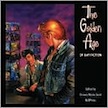 The Golden Age of Gay Fiction
The Golden Age of Gay Fiction
Edited by Drewey Wayne Gunn
MLR Press. 280 pages, $69.99
ASSUMPTIONS about what gay life and culture were like before Stonewall—that it was an era of all-consuming repression, secrecy, and shame—might lead one to conclude that depictions of gay people in film and literature were non-existent or, if they did surface, heavily coded. Many film historians have examined the movies of this period, but the history of gay literature, which arguably provides perhaps an even richer history, has not been explored as thoroughly. Of course, one must be willing to allow for a more expansive and inclusive definition of what constitutes “literature.”
David Leavitt and Mark Mitchell’s 1998 anthology, Pages Passed from Hand to Hand: The Hidden Tradition of Homosexual Literature in English from 1748 to 1914, provided a helpful survey of homosexual themes that were found during this period. The book’s title also serves as a good description of how gay writing found its audience in the early decades of the twentieth century. Books with gay themes and characters, whether coded or overt, found their following through networks of appreciative readers who shared them with fellow travelers. This “underground railroad” of sorts was necessary because many libraries and booksellers simply refused, on “moral” grounds, to make GLBT books available. In 1948, for example, when Gore Vidal’s The City and the Pillar was published, many critics would not review it, and it was even denied advertising space due to its homosexual subject matter. And Vidal certainly wasn’t the only writer who was subject to this kind of treatment.
But the advent of cheap paperback books changed all that, and this is the story that’s wonderfully chronicled in The Golden Age of Gay Fiction, Drewey Wayne Gunn’s collection of essays. Gunn dates this golden age from 1948 to 1978, a three-decade period in which many important gay writers began producing significant fiction, and paperback publishing made affordable copies of these books widely available to the public. Gunn’s collection begins with a thorough historical survey. Ian Young, in “The Paperback Explosion: How Gay Paperbacks Changed America” (one of two contributions), examines both the cultural history that informed the early repression of gay literature and the forces that freed it. For Young, the history of the paperback begins much earlier than their widespread availability in the late 1940’s. He cites the example of paperbound books from 17th-century Europe as the earliest appearance of the concept. Much later, the arrival of cheap “pulps” in the early 20th century, the founding of Penguin Books in 1935, and the Armed Services Editions printed for soldiers in World War II laid the foundation for the broader popularity of paperbacks soon thereafter.
Young’s essay also includes a helpful and funny explication of the often lurid cover art that publishers used to help sell their books. He identifies numerous cover art motifs in gay paperback fiction (categories include “The Concerned Woman,” “Looking Away,” and “Cruising”). This essay—and, for that matter, the entire book—is richly illustrated with examples of this colorful paperback cover art.
Michael Bronski’s essay, “Back to the Future: Recovering Our Gay Literary Past” (an earlier version of which appeared in the January-February 2009 issue of this publication), describes how the author’s own thinking about early gay fiction evolved during and after the writing of his 2003 book, Pulp Friction, a history of gay pulp fiction. Bronski comes to realize that the category of pulp is more diverse than he initially believed, since it contains not only varying degrees of what we could call porn, but also a broad array of more serious, even literary novels. What’s most arresting, in his view, is the revelation that not all pre-Stonewall gay fiction depicted sad, lonely, and tragic gay figures.
In addition to scholarly essays, Gunn also includes more personal, even memoir-like examinations of how gay literature affected its audience. In Dennis Bolin’s “A Conversation in a Coffee Shop,” for example, the writer shares his personal reactions to his first experiences with gay paperback literature. Other essays devoted to gay publishing history focus on particular pulp authors, such as Donald Webster Cory, James Barr, Rodney Garland, and others. A later section of the book contains essay-length appreciations of the works of Victor Banis, Gordon Merrick, and Lonnie Coleman. There are also studies of gay writing in the genres of science fiction, westerns, mysteries, and military-themed fiction.
Gunn’s project, and that of his contributors, is to reclaim the history of what has often been called the forgotten gay literature. In his introduction to the book, Gunn even takes some gay authors of the Violet Quill group to task for “in all innocence, creating the myth that it was their efforts that were mostly responsible” for laying the foundations of contemporary gay writing. In his effort to ensure that gay pulp writers get their due, Gunn includes several essays from these writers, who provide their perspective on what it was like to be writing from the trenches during the heyday of gay pulp. It wasn’t always pretty, of course, but it’s fascinating to read these accounts by the likes of Jan Ewing, Victor Banis, William Maltese, and Earl Kemp, among others. The Golden Age of Gay Fiction is admirably broad in scope. Through its generous use of cover art illustrations, in addition to the caliber of the writing, this book more than does justice to its subject.
Jim Nawrocki, a frequent contributor, lives in San Francisco.





